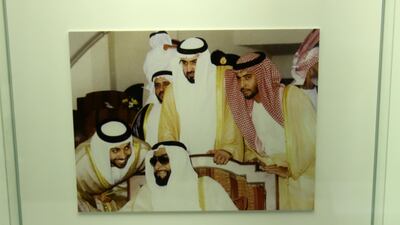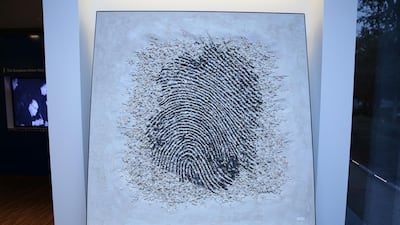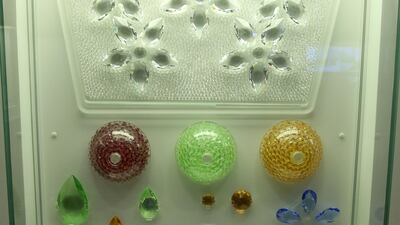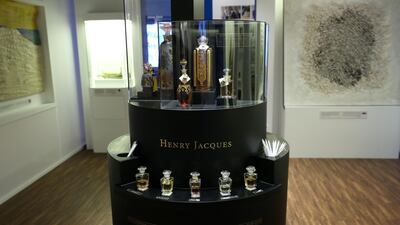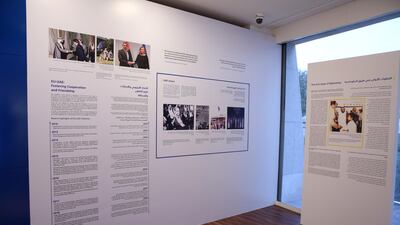In the far corner of the third room of Sheikh Zayed and Europe: A Journey, a fascinating exhibition at the Founder's Memorial in Abu Dhabi, is a speaker and a button. Press the button and the anthem of the European Union, taken from Beethoven's Ninth Symphony, fills the air, loud and proud. It is, needless to say, strange to be in the UAE, looking at photographs of Sheikh Zayed, while this defiant European composition is playing.
But It is also absolutely appropriate. As this show, which has been extended until January 31, eloquently argues, the history of the UAE is intricately tied to the history of the EU. In 1951, Sheikh Zayed visited Europe as a member of a delegation from the emirate of Abu Dhabi. This was, incidentally, the year the Treaty of Paris, widely acknowledged as the first step towards the EU, was signed. The photographs displayed here from this trip are a joy: Sheikh Zayed visiting Capitoline Hill in Rome, St Peter's Square in Vatican City, and the Eiffel Tower in Paris.
'He visited museums like the Louvre'
And as the exhibition notes point out, Sheikh Zayed was so impressed with what he saw in Europe that, years later, it inspired aspects of his vision for the UAE, which was formed in 1971. "[He] visited museums like the Louvre in Paris and said that one day, there will be a museum like that in the UAE," reveals Minister of State, Zaki Nusseibeh, in a quote on the wall.
Sheikh Zayed and Europe: A Journey, is a celebration then, of a cultural and political relationship that has thrived for decades. There are, for example, 200,000 EU citizens living in the UAE, while the EU is the UAE's largest trading partner. But these things did not happen by accident; it has taken years of co-operation and goodwill.
One wall in the second room is lined with photographs of Sheikh Zayed with European leaders, from Italian Prime Minister Giulio Andreotti, in 1991, to the President of Finland Martti Ahtisaari in 1996. And there is a vast interactive map of Europe, which allows visitors to learn about the UAE's relationship with any country in the EU at the touch of a screen. The UK is still there – for now. Wisely, the curators have steered clear of Brexit.
The exhibition is, for the most part, composed of photographs and nuggets of information to be chewed over. The history of the Euro symbol is particularly well presented; there is a timeline of recent EU-UAE relations; and an extended interview, printed on one wall, with Sheikh Abdullah bin Zayed Al Nahyan, UAE Minister of Foreign Affairs, in which he discusses his father’s relationship with Europe’s leaders. “From the start,” he says, “this partnership was built on a vision of shared interests and values, shared resources, and shared commitment to peace and prosperity.”
Smell his perfume, see his chandelier
But it is not just a history lesson. There are also plenty of striking exhibits and neat interactive touches. You can sample five of Sheikh Zayed’s favourite fragrances, created exclusively by French Haute Parfumerie House, Henry Jacques. Or marvel at a cabinet of enormous crystals from the chandeliers in the Sheikh Zayed Grand Mosque, manufactured by a German-Italian company.
Best of all, though, is an enormous mosaic, made from marble, glass, gold and sand from the UAE desert, depicting Sheikh Zayed’s fingerprint. Created by Slovenian artist Aljaz Vidrajz, it dominates the room, a vibrant constellation of colours and textures. Never mind its diplomatic purpose, this is just a stunning piece of craftsmanship.
The exhibition works so well because it maintains a coherent argument throughout. Each item – whether it’s a photograph, jewel or bottle of fragrance – supports the idea that the EU and the UAE share a recent history.
In fact, the only misstep comes in the opening room when we are whisked further back in time. Here, we are told about German Flemish cartographer Gerard Mercator's 16th century maps of the region and about an 18th century Europe-led expedition to Arabia. It feels like a different history altogether, one which is dominated by Western innovation and power. To take the leap from this period in one room to the 20th century and Sheikh Zayed's trip to Europe in the next feels awkward – it is as if a section from another show entirely has been tacked on to this one.
This, though, is a minor criticism. At a time when the EU is threatening to fracture and fall apart, Sheikh Zayed and Europe: A Journey is a reminder that we are – both here and in Europe – much better off together.
Sheikh Zayed and Europe: A Journey is at the Founder’s Memorial until January 31. For more information, visit: www.SZandEurope.com
___________________
Read more:
Visualising Palestine: recounting an historic conflict through maps
Middle of what? The tricky business of labelling regional art
Art Bahrain: the people bringing Bahraini art to the world
____________________

